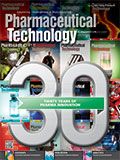Celebrating in Style
Pharmaceutical Technology Europe
Pharmaceutical Technology Europe celebrates 30 years in publishing the latest insights, analysis, and developments of the bio/pharma industry.
Happy birthday, bon anniversaire, Alles Gute zum Geburtstag, feliz cumpleaños, penblwydd hapus, Grattis på födelsedagen, van harte gefeliciteerd, lá breithe shona duit, and so on. Whichever language is used, birthday wishes tend to be joyous and celebratory, resulting in lots of presents and delicious cake. Pharmaceutical Technology Europe, in case you may have missed it, is celebrating 30 years of publishing the latest developments and news from the industry. For us, our ‘presents’ are probably best represented by our dedicated readership and our ‘cake’ the informative content that has been eagerly digested over the years.
Thinking about anniversaries, and in particular those of scientific accomplishment, I wondered if this year marked a special one for other aspects of the scientific community. A well-publicized anniversary is that of the moon landing, which offered the global scientific community a significant ‘leap’ forward in 1969. Going back in time a little further, to 1869 in fact, and Dimitri Mendeleev was busy formulating the first ever periodic table, something that I personally (as a Chemist) could not have lived without during my time in academia. Even earlier, 50 years prior to Mendeleev’s triumph, Thomas Young published a paper that assessed the reliability of experimental results through the use of a probability theory.
Looking at the pharmaceutical industry in particular, 1939 was the year when work on the purification and chemistry of penicillin began-11 years after its discovery-which, once commercially produced, would herald the era of antibiotics. Thirty years after research began into penicillin, the pharmaceutical industry would see the introduction of ibuprofen, a non-steroidal anti-inflammatory that is a popular pain killer for many patients today. The same year Pharmaceutical Technology Europewas published, the pharmaceutical industry witnessed the introduction of the first ever proton pump inhibitor, and, within Europe the first guidelines on good manufacturing practices, which would set the course for improved quality of medicines in the region.
Reaching a milestone
As a result of reaching the milestone of three decades in publishing, this August issue of Pharmaceutical Technology Europe features some special content focusing on the past, present, and future of various sectors within the bio/pharmaceutical industry. Over the next 70 or so pages, not only can you read the usual high calibre content the magazine is known for, but we have also created some bespoke content in consideration of our anniversary.
To begin, on pages 12–14, the cover story editorial includes a brief timeline of some of the big news that has shaped the bio/pharma industry in Europe during the past 30 years. Continuing our anniversary content, there are 10 special one-to-one interviews with industry experts, which highlight key trends within various fields.
Outsourcing: Some of the key factors driving growth in the contract development and manufacturing organization (CDMO) market, the evolution of the CDMO-pharma relationship, and the move towards more complex drugs are reviewed.
Biopharma: Chief transformations in the biopharma market, the potential of vaccines, and technological advancements integral to the future of the sector are discussed.
Analytical instrumentation: Advancements in analytical instrumentation that have occurred over the past 30 years, how developers have overcome industry’s slow adoption of new technologies, and future trends are examined.
Equipment: The importance of machine vision systems in an ever-evolving bio/pharma security landscape and predictions of inspection technology improvements for packaging are considered.
APIs: The evolution of APIs-from blockbuster towards more niche, potent drugs-is assessed, as well as the impact this change has had on the pharma supply chain.
Packaging: How glass vials have journeyed from the mere commodity products to becoming an integral part of the final drug product is deliberated.
Regulatory/GMP compliance: The introduction of good manufacturing practices in Europe, which was a major step forward in regulatory harmonization, is discussed, along with some of the works taking place to continue harmonization in the future.
Article Details
Pharmaceutical Technology Europe
Vol. 31, No. 8
July 2019
Page: 6
Citation
When referring to this article, please cite it as F. Thomas, “Celebrating in Style,” Pharmaceutical Technology Europe 31 (8) 2019.

Drug Solutions Podcast: A Closer Look at mRNA in Oncology and Vaccines
April 30th 2024In this episode fo the Drug Solutions Podcast, etherna’s vice-president of Technology and Innovation, Stefaan De Koker, discusses the merits and challenges of using mRNA as the foundation for therapeutics in oncology as well as for vaccines.
PacBio Chosen as Tech Partner for Global Alzheimer’s Disease Research Project
April 23rd 2025The project, the North African Dementia Registry, will unite multiple entities for the purpose of developing a comprehensive dataset to advance the research community’s understanding of Alzheimer’s disease and other dementias in diverse populations.